Substitution Reactions of Benzene Derivatives
- Page ID
- 1208
When substituted benzene compounds undergo electrophilic substitution reactions, two related features must be considered.
Relative reactivity
The first is the relative reactivity of the compound compared with benzene itself. Experiments have shown that substituents on a benzene ring can influence reactivity in a profound manner. For example, a hydroxy or methoxy substituent increases the rate of electrophilic substitution about ten thousand fold, as illustrated by the case of anisole in the virtual demonstration (above). In contrast, a nitro substituent decreases the ring's reactivity by roughly a million. This activation or deactivation of the benzene ring toward electrophilic substitution may be correlated with the electron donating or electron withdrawing influence of the substituents, as measured by molecular dipole moments. In the following diagram we see that electron donating substituents (blue dipoles) activate the benzene ring toward electrophilic attack, and electron withdrawing substituents (red dipoles) deactivate the ring (make it less reactive to electrophilic attack).
 |
The influence a substituent exerts on the reactivity of a benzene ring may be explained by the interaction of two effects:
Inductive and Conjugation Effects
The first is the inductive effect of the substituent. Most elements other than metals and carbon have a significantly greater electronegativity than hydrogen. Consequently, substituents in which nitrogen, oxygen and halogen atoms form sigma-bonds to the aromatic ring exert an inductive electron withdrawal, which deactivates the ring (left-hand diagram below).
The second effect is the result of conjugation of a substituent function with the aromatic ring. This conjugative interaction facilitates electron pair donation or withdrawal, to or from the benzene ring, in a manner different from the inductive shift. If the atom bonded to the ring has one or more non-bonding valence shell electron pairs, as do nitrogen, oxygen and the halogens, electrons may flow into the aromatic ring by p-π conjugation (resonance), as in the middle diagram. Finally, polar double and triple bonds conjugated with the benzene ring may withdraw electrons, as in the right-hand diagram. Note that in the resonance examples all the contributors are not shown. In both cases the charge distribution in the benzene ring is greatest at sites ortho and para to the substituent.
In the case of the nitrogen and oxygen activating groups displayed in the top row of the previous diagram, electron donation by resonance dominates the inductive effect and these compounds show exceptional reactivity in electrophilic substitution reactions. Although halogen atoms have non-bonding valence electron pairs that participate in p-π conjugation, their strong inductive effect predominates, and compounds such as chlorobenzene are less reactive than benzene. The three examples on the left of the bottom row (in the same diagram) are examples of electron withdrawal by conjugation to polar double or triple bonds, and in these cases the inductive effect further enhances the deactivation of the benzene ring. Alkyl substituents such as methyl increase the nucleophilicity of aromatic rings in the same fashion as they act on double bonds.
 |
Isomerization
The second factor that becomes important in reactions of substituted benzenes concerns the site at which electrophilic substitution occurs. Since a mono-substituted benzene ring has two equivalent ortho-sites, two equivalent meta-sites and a unique para-site, three possible constitutional isomers may be formed in such a substitution. If reaction occurs equally well at all available sites, the expected statistical mixture of isomeric products would be 40% ortho, 40% meta and 20% para. Again we find that the nature of the substituent influences this product ratio in a dramatic fashion. Bromination of methoxybenzene (anisole) is very fast and gives mainly the para-bromo isomer, accompanied by 10% of the ortho-isomer and only a trace of the meta-isomer. Bromination of nitrobenzene requires strong heating and produces the meta-bromo isomer as the chief product.
 |
Some additional examples of product isomer distribution in other electrophilic substitutions are given in the table below. It is important to note here that the reaction conditions for these substitution reactions are not the same, and must be adjusted to fit the reactivity of the reactant C6H5-Y. The high reactivity of anisole, for example, requires that the first two reactions be conducted under very mild conditions (low temperature and little or no catalyst). The nitrobenzene reactant in the third example is very unreactive, so rather harsh reaction conditions must be used to accomplish that reaction.
|
Y in C6H5–Y |
Reaction |
% Ortho-Product |
% Meta-Product |
% Para-Product |
|---|---|---|---|---|
| –O–CH3 | Nitration | 30–40 | 0–2 | 60–70 |
| –O–CH3 | F-C Acylation | 5–10 | 0–5 | 90–95 |
| –NO2 | Nitration | 5–8 | 90–95 | 0–5 |
| –CH3 | Nitration | 55–65 | 1–5 | 35–45 |
| –CH3 | Sulfonation | 30–35 | 5–10 | 60–65 |
| –CH3 | F-C Acylation | 10–15 | 2–8 | 85–90 |
| –Br | Nitration | 35–45 | 0–4 | 55–65 |
| –Br | Chlorination | 40–45 | 5–10 | 50–60 |
These observations, and many others like them, have led chemists to formulate an empirical classification of the various substituent groups commonly encountered in aromatic substitution reactions. Thus, substituents that activate the benzene ring toward electrophilic attack generally direct substitution to the ortho and para locations. With some exceptions, such as the halogens, deactivating substituents direct substitution to the meta location. The following table summarizes this classification.
Orientation and Reactivity Effects of Ring Substituents |
|||||||
|---|---|---|---|---|---|---|---|
|
ctivating Substituents |
Deactivating Substituents |
Deactivating Substituents |
|||||
| –O(–) –OH –OR –OC6H5 –OCOCH3 |
–NH2 –NR2 –NHCOCH3 –R –C6H5 |
–NO2 –NR3(+) –PR3(+) –SR2(+) –SO3H –SO2R |
–CO2H –CO2R –CONH2 –CHO –COR –CN |
–F –Cl –Br –I –CH2Cl –CH=CHNO2 |
|||
The information summarized in the above table is very useful for rationalizing and predicting the course of aromatic substitution reactions, but in practice most chemists find it desirable to understand the underlying physical principles that contribute to this empirical classification. We have already analyzed the activating or deactivating properties of substituents in terms of inductive and resonance effects, and these same factors may be used to rationalize their influence on substitution orientation.
The first thing to recognize is that the proportions of ortho, meta and para substitution in a given case reflect the relative rates of substitution at each of these sites. If we use the nitration of benzene as a reference, we can assign the rate of reaction at one of the carbons to be 1.0. Since there are six equivalent carbons in benzene, the total rate would be 6.0. If we examine the nitration of toluene, tert-butylbenzene, chlorobenzene and ethyl benzoate in the same manner, we can assign relative rates to the ortho, meta and para sites in each of these compounds. These relative rates are shown (colored red) in the following illustration, and the total rate given below each structure reflects the 2 to 1 ratio of ortho and meta sites to the para position. The overall relative rates of reaction, referenced to benzene as 1.0, are calculated by dividing by six. Clearly, the alkyl substituents activate the benzene ring in the nitration reaction, and the chlorine and ester substituents deactivate the ring.
 |
From rate data of this kind, it is a simple matter to calculate the proportions of the three substitution isomers. Toluene gives 58.5% ortho-nitrotoluene, 37% para-nitrotoluene and only 4.5% of the meta isomer. The increased bulk of the tert-butyl group hinders attack at the ortho-sites, the overall product mixture being 16% ortho, 8% meta and 75% para-nitro product. Although chlorobenzene is much less reactive than benzene, the rate of ortho and para-substitution greatly exceeds that of meta-substitution, giving a product mixture of 30% ortho and 70% para-nitrochlorobenzene. Finally, the benzoic ester gave predominantly the meta-nitro product (73%) accompanied by the ortho (22%) and para (5%) isomers, as shown by the relative rates. Equivalent rate and product studies for other substitution reactions lead to similar conclusions. For example, electrophilic chlorination of toluene occurs hundreds of times faster than chlorination of benzene, but the relative rates are such that the products are 60% ortho-chlorotoluene, 39% para and 1% meta-isomers, a ratio similar to that observed for nitration.
The manner in which specific substituents influence the orientation of electrophilic substitution of a benzene ring is shown in the following interactive diagram. As noted on the opening illustration, the product-determining step in the substitution mechanism is the first step, which is also the slow or rate determining step. It is not surprising, therefore, that there is a rough correlation between the rate-enhancing effect of a substituent and its site directing influence. The exact influence of a given substituent is best seen by looking at its interactions with the delocalized positive charge on the benzenonium intermediates generated by bonding to the electrophile at each of the three substitution sites. This can be seen in seven representative substituents beneath the following diagram.
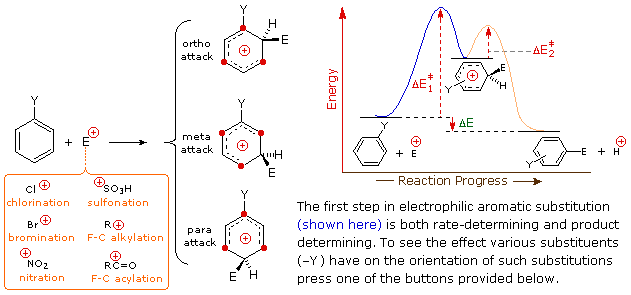 |
|||||||
Y– |
CH3 |
Cl or Br |
NO2 |
RC=O |
SO3H |
OH |
NH2 |
|---|---|---|---|---|---|---|---|
CH3 substitution
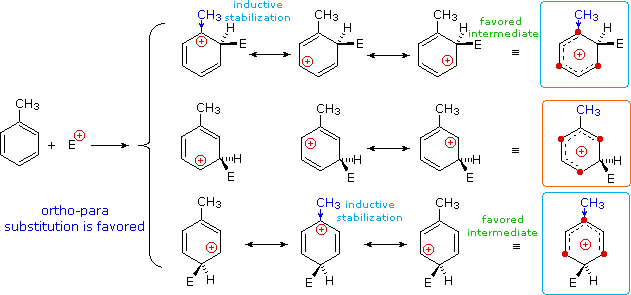
In the case of alkyl substituents, charge stabilization is greatest when the alkyl group is bonded to one of the positively charged carbons of the benzenonium intermediate. This happens only for ortho and para electrophilic attack, so such substituents favor formation of those products. Interestingly, primary alkyl substituents, especially methyl, provide greater stabilization of an adjacent charge than do more substituted groups (note the greater reactivity of toluene compared with tert-butylbenzene).
NO2 substitution
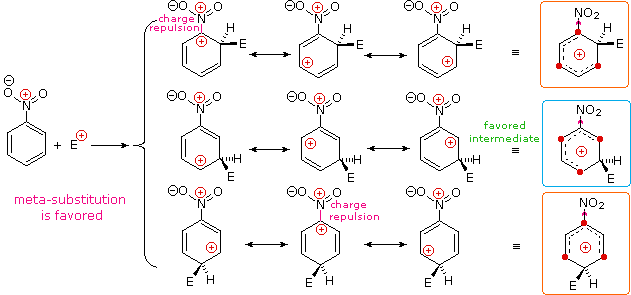
R-CO substitution
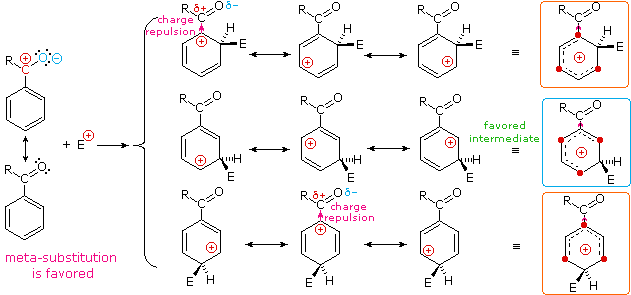
SO3 substitution

Nitro (NO2), sulfonic acid (SO3H) and carbonyl (C=O) substituents have a full or partial positive charge on the atom bonded to the aromatic ring. Structures in which like-charges are close to each other are destabilized by charge repulsion, so these substituents inhibit ortho and para substitution more than meta substitution. Consequently, meta-products predominate when electrophilic substitution is forced to occur.
Halide substitution
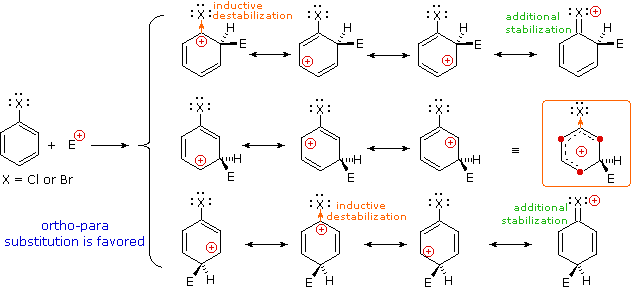
OH substitution
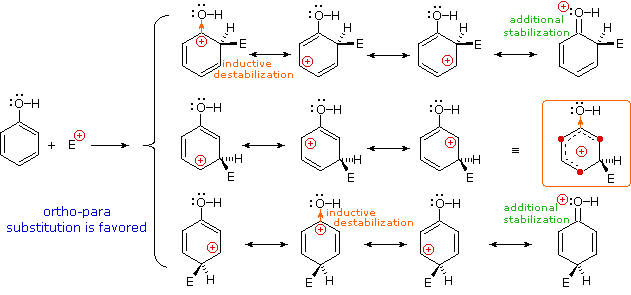
NH2 substitution
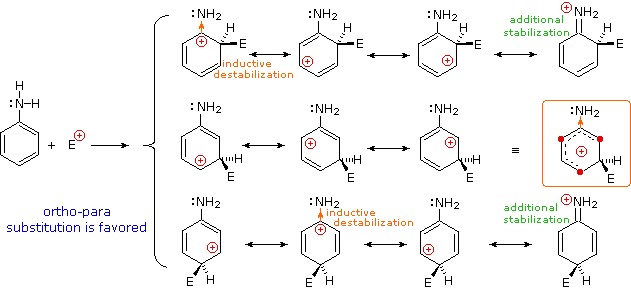
Halogen (X), OR and NR2 substituents all exert a destabilizing inductive effect on an adjacent positive charge, due to the high electronegativity of the substituent atoms. By itself, this would favor meta-substitution; however, these substituent atoms all have non-bonding valence electron pairs which serve to stabilize an adjacent positive charge by pi-bonding, with resulting delocalization of charge. Consequently, all these substituents direct substitution to ortho and para sites. The balance between inductive electron withdrawal and p-π conjugation is such that the nitrogen and oxygen substituents have an overall stabilizing influence on the benzenonium intermediate and increase the rate of substitution markedly; whereas halogen substituents have an overall destabilizing influence.
Contributors
- William Reusch, Professor Emeritus (Michigan State U.), Virtual Textbook of Organic Chemistry


